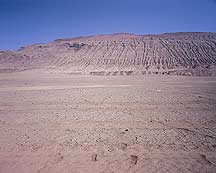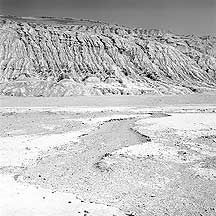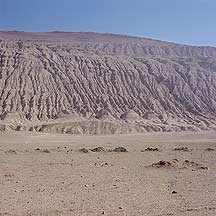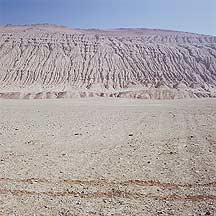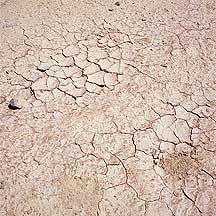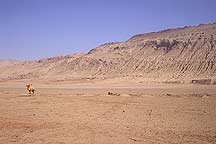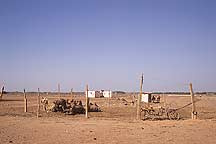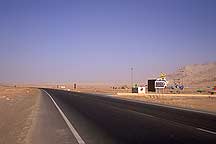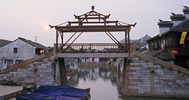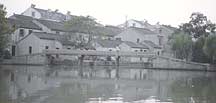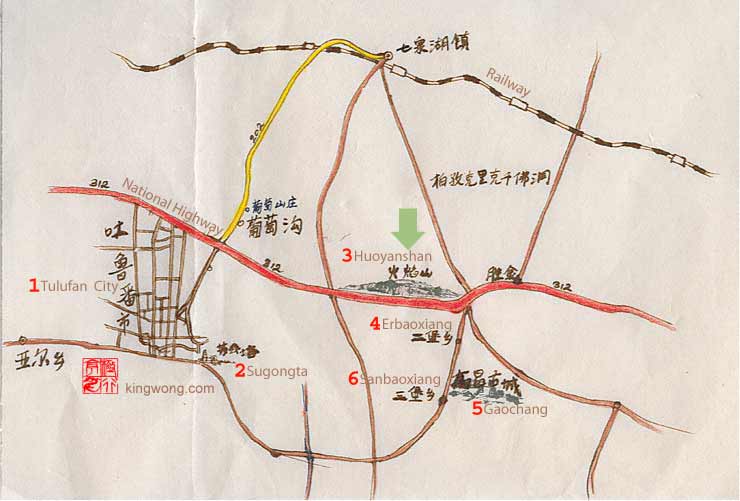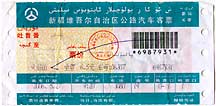 Text continues from above.
Text continues from above.
三藏闻言, 起身称谢道: “敢问公公: 贵处遇秋, 何返炎热?” 老者道:“敝地唤做火焰山。 无春无秋, 四季皆热。” 三藏道:“火焰山却在那边? 可阻西去之路?“ 老者道:”西方却去不得。 那山离此有六十里远, 正是西方必由之路, 却有八百里火焰,四周寸草不生。 若过得山, 就是铜脑盖, 铁身躯, 也要化成汁哩。! 三藏闻言, 大惊失色, 不敢再问。
Upon hearing what had been said, Sanzang gets up and ask gratefully: U "Mr., may I ask: Autumn has arrive in this area, but why such returning heat?" The old man replies: "Our area is the domain of the Flaming Mountains, with neither spring nor autumn — all four seasons of heat." Sanzang inquires again: "Where is this Huoyan Shan? And how can it block the westward road?" The old man again replies: "It is impossible to go west: That mountain is 60 li away, right on the road toward west, and it has eight hundred flames — all around not an inch of grass grows. If anyone were to pass this mountain — even with a bronze head and a metal body — one would still turn to juice." Hearing this, Sanzang lost his color and would not dare ask further.1
The largely fictional novel, which chronicles the westward journey of the historical 唐朝Tang Dynasty (618 - 907) monk 玄奘Xuan Zhuang (602 - 664), who made the treacherous trip to India to obtain Budddhist scriptures for studies, also provides a story on the origin of the Flaming Mountains: During the time when 孙悟空Sun Wukong (the Monkey Lord, the main character of the novel, who later became the disciple of the fictional monk) and his monkey armies rebel against Heaven. He creates unstoppable havoc. After numerous embarassing defeats, the heavenly forces finally catch the unconventional monkey. When all methods fail to execute the Monkey King, he is then place inside a furnace and burn continuously for 49 days. But just when he is thought to have turned to ash, he breaks out and knocks down the furnace, whereby some charcoals fall down to earth and became the Huoyan Shan.
The local Uygur ethnic people has their own legend: It was said that a vicious dragon dwelled in the 天山Tian Shan mountains. And this monster has the horrible appetite for children's flesh. So a young Uygur hero got hold of a mighty sword and battled with the creature for some tireless days. He eventually slayed the dragon and sliced it into pieces; the bloody remains of its body became the Flaming Mountains.
I spent a couple of hours in front of these mountains when I was here. I walked a close distance to its base and set up my 4x5 on a tripod. Most of the time I was wiping sweat and checking out who else was out here baking other than the camels and me. For the 2 hours outside I felt the burning heat through my sneakers' sole, so I stood on one leg to cool off the other. A staff thought I might soon turned to charcoal, so he drove his rover up to me to see if I am ok. He offered me a ride back to the underground mall, but I declined. Before he left, he handed me a bottle of water and wished me well. There were a couple of things one can do here: to have a picture taken on top of a camel, or if you are really adventurous, you may hire a rover to climb up the hill. You may climb up yourself, of course. The view up there must be awesome. The main tourist part of the mountains, the one with the most gullies, are fenced.
To enter, one gets a ticket and passes through an unbelievable underground mall (richly decorated with themes from the famous book) and spirals up a large hole and out through a small opening, and then be surprised by these phenomenal blazing red hills. In the center of this large hole was a huge thermometer in the shape of Monkey King's famous cudgel, and it pointed up against the sky.

